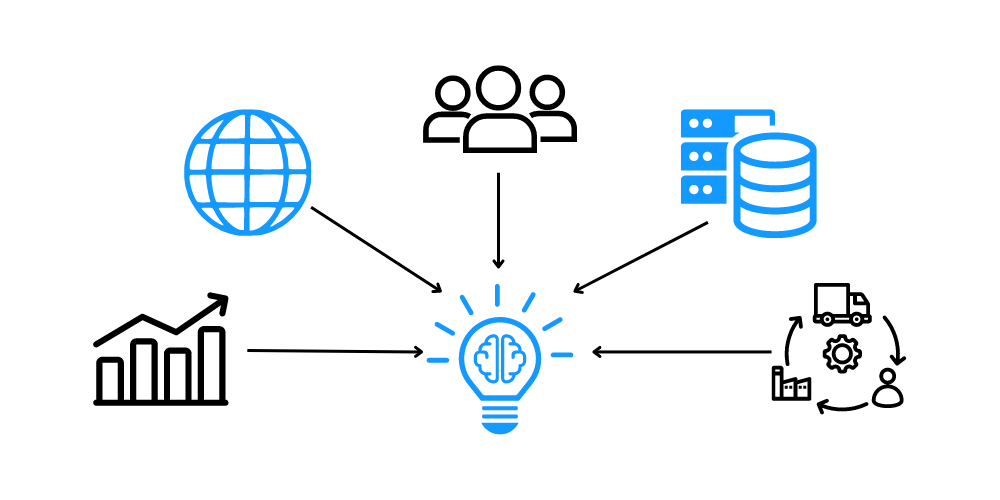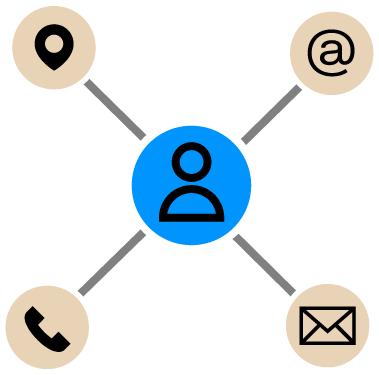We live in a world of increasing complexity - from the data that informs business decisions, to the IT systems that power operations, to the international supply chains that enable commerce. In a world of such connected and interdependent systems, understanding context is no longer a “nice to have” but an absolute necessity.
Without the proper context, it's easy to miss critical signals in the noise. By understanding the full picture around you and connecting the dots across disparate data points from different sources, you’ll be better equipped to uncover key insights. Insights that empower you to make fully informed business decisions to reduce risks or improve the operational efficiency of your organization. For example, a supply chain manager needs knowledge of order data, weather patterns, shipping routes, and more in order to accurately anticipate potential bottlenecks or delays, and to effectively respond to any incidents that may arise.
But breaking down silos to get the full picture is challenging. The data that holds the keys to critical business knowledge tends to be fragmented across an organization stored in domain-specific databases and documents. Piecing together the contextual intelligence required for strategic decision making can take tremendous time and effort.
This is where the right tools can help close the gap. Graph-powered solutions, for example, are emerging as a powerful way to connect data across vast and heterogeneous datasets to deliver the contextual intelligence that drives better business outcomes.
In this article, we'll explore why contextual intelligence provides such an impactful competitive advantage for today's data-driven businesses, and how the right technology can help deliver the insights you need.
Contextual intelligence, also called situational intelligence, refers to the ability to continuously monitor and analyze the contextual environment to uncover insights that can be applied to ongoing or future scenarios to inform better decisions. The contextual environment might include elements such as economic, technological, geopolitical, or cultural factors, to give some examples. Contextual intelligence requires synthesizing disparate data points and identifying relationships between them to see the full picture.

Contextual intelligence is a key enabler of decision intelligence, which is the discipline of enhancing business decision making using tools like data analysis, automation, and artificial intelligence. While decision intelligence focuses on the decision-making process itself, contextual intelligence focuses specifically on utilizing context to uncover the insights that should guide decisions.
Contextual intelligence delivers several key benefits when applied to business decision making. Here are some of the key reasons why contextual intelligence is so important:
Contextual intelligence enables more accurate, fully-informed decisions by providing decision makers with a complete view of all relevant data. Rather than decisions being made in a vacuum based on limited datasets, leaders can leverage context from across the organization to see the whole picture so assumptions can be validated or invalidated, blind spots revealed, and unintended consequences anticipated.
Contextual intelligence, in analyzing the full business environment, can help leaders proactively zero in on inefficiencies or bottlenecks. In doing so, it empowers organizations to avoid potential problems before they start, improving overall business efficiency.
By deeply understanding the context, organizations can better predict risks and proactively put in place mitigation strategies. Contextual intelligence enables leaders to connect insights across data sources to identify early warning signals of emerging risks.
Contextual intelligence brings benefits to all kinds of organizations. Let's take a look at a couple of examples.
Crimes like money laundering, fraud, and terrorist financing often involve complex, interconnected networks of entities and transactions that can be difficult to untangle using traditional methods. By applying contextual intelligence, financial institutions can gain a unified view of customers, transactions, and third-party relationships across the organization's data sources.
This multilayered context enables a more holistic, risk-based approach to AML or anti-fraud programs. Rather than relying on alerts based on simple rules or thresholds, institutions can proactively identify potentially suspicious customer networks, transaction corridors, and threat typologies for further investigation.
In very large organizations with many departments or many offices, it can be challenging to keep track of team dynamics. Organizational network analysis is essentially an exercise in contextual intelligence to ensure a high degree of visibility over these dynamics. By mapping out formal and informal relationships among people, teams, communities, and more within the organization and analyzing the resulting network, you can identify patterns and insights that ultimately help improve organizational health and performance.
There are many moving parts in any modern supply chain, which brings together disparate people, places, and parts. Supply chains can also be disrupted by any number of things: geopolitical turmoil, meteorological incidents, fluctuations in consumer habits, etc. By gathering a maximum amount of context, supply chain managers can anticipate disruptions and changes, and develop informed contingency plans to minimize business impact when problems do arise.
As organizations contend with ever-growing datasets and increasingly complex business operations, traditional analytical solutions often fall short in delivering the contextual insights required for strategic decision making. This is where graph visualization and analytics have emerged as powerful tools to deliver a maximum amount of context from data.
In a graph data model, data is structured and stored as a network of relationships. Individual entities or data points are called nodes. And those nodes are connected by edges, which represent the relationships between entities. Nodes can represent all kinds of things: people, places, accounts, suppliers, and more, while edges show you how any of those data points are related to each other.
Graph visualizations show both the direct and indirect connections between nodes, delivering full context around the data. This allows you to see how entities relate to each other through multiple levels of connection, which is extremely difficult to discern in row-and-column based analysis.

By embracing the importance of relationships as first-class citizens, graph technology is particularly well suited for contextualizing information. By analyzing the connections within your data, you can understand critical patterns, trends, and dependencies that are nearly impossible to identify with more traditional, siloed analysis methods.
Graph also excels at navigating even the most complex and interconnected datasets. This gives decision makers comprehensive context at multiple levels, delivering a holistic understanding of the data required for fully informed choices. Whether it's analyzing supply chain interdependencies, fraud connections, or customer journey mapping, graph technology is purpose-built for contextual intelligence.
Ready to get a deeper contextual understanding of your organization’s data? Natively built on graph technology, Linkurious Enterprise enables you to interactively visualize and analyze your graph data, intuitively navigating its interactions to uncover the insights within. You can also go beyond simple graph visualization. Linkurious Enterprise also easily integrates with other technologies like entity resolution solutions, databases, NLP, and more to provide an end to end modular contextual intelligence tool.
Discover the hidden relationships, identify critical patterns, and gain a comprehensive understanding of your data's contextual landscape - all before lunch. Try it today.